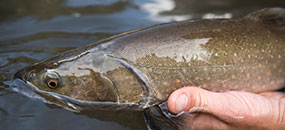Fly fishing in the Tongass National Forest. Photo: Paula Dobbyn
by Cindy Shogun
Last week, U.S. Forest Service Chief Tom Tidwell testified before the Senate Interior, Environment, and Related Agencies Subcommittee to discuss the 2016 Forest Service budget request. And in the midst of back-and-forth between Chief Tidwell and Sen. Lisa Murkowski (R-Alaska) on how best to support southeast Alaska’s flagging timber industry, there flickered the light of growing consensus on an extremely important issue - the need to allocate more resources to support the burgeoning tourism, recreation and fishing businesses in the region. On this point, we agree. It is indeed time to increase the Tongass’ recreation budget, which supports the largest private, sustainable, job creating industries in the region – tourism and fishing.
Fishing and tourism contribute approximately 7,000 and 11,000 jobs respectively and pump around $1 billion apiece annually into southeast Alaska. The visitor services industry alone results in $1.1 billion in annual spending: beyond the costs of hiring a guide or outfitting for a trip, booking a hotel or eating in a restaurant, millions of dollars are raised from things such as sales tax revenues, bed tax revenues, and dockage and moorage fees. The fishing industry and related services that depend on the Tongass includes everything from the commercial seafood industry and recreational/sport and personal use/subsistence fishing, to hatchery operations and processing.
In 2010 Secretary of the U.S. Department of Agriculture Tom Vilsack issued a letter calling for a “transition framework” for the Tongass with the goal of providing and supporting forest-dependent jobs around the region’s economic powerhouses and moving away from old-growth logging. Yet a recent study from Headwaters Economics found that four years into the “transition” very little has changed; the Forest Service continues to invest taxpayer dollars at a disproportionate rate into timber while neglecting recreation, tourism and fishing.
Douglas harbor near Juneau. Photo by Paula Dobbyn
In fact, despite a growing demand for recreation services, over the past five years the Forest Service has repeatedly cut funding and staff for the very programs that generate the most money and jobs in southeast Alaska. Increasing funding for recreation programs is crucial to supporting tourism and fishing, which rely to such a large degree on a healthy forest and watersheds. More than 1 million people visit the region annually, and the majority of these people come to see world-class temperate forest habitat, an endless variety of iconic wildlife – including bald eagles, brown bears and the uniquely Alaskan Alexander Archipelago wolf, or to catch wild salmon in one of many pristine watersheds…not to see clear-cuts.
Meanwhile we continue to fund a Tongass timber program that on average has cost taxpayers more than $20 million annually during the past five years. The Forest Service will spend $57 million in the Tongass preparing and administering the controversial Big Thorne timber contract yet receive only $6 million in timber sale receipts, for a net cost to taxpayers of more than $50 million. That is math that simply isn’t acceptable.
The reality is this: fishing and tourism in southeast Alaska are billion-dollar industries that support thousands of jobs. Yet according to Headwaters, fishing receives only 13 percent of the Forest Service budget, and tourism only 15 percent. Timber? Timber accounts for less than 1 percent of regional employment but takes up 37 percent of the Forest Service’s budget, all while costing taxpayers millions in subsidies. If we’re serious about building healthy communities and a healthy economy in southeast Alaska – and in maintaining the Tongass as the crown jewel of our national forest system – it’s time the Forest Service and Congress started working together to increase investment into the Tongass’ recreation programs. Why not put taxpayer dollars where they will give us the largest return on our investment year after year, and allow us to preserve a national treasure in the process.
Cindy Shogan is executive director of the Alaska Wilderness League. This article originally appeared in The Hill on March 25, 2015.








